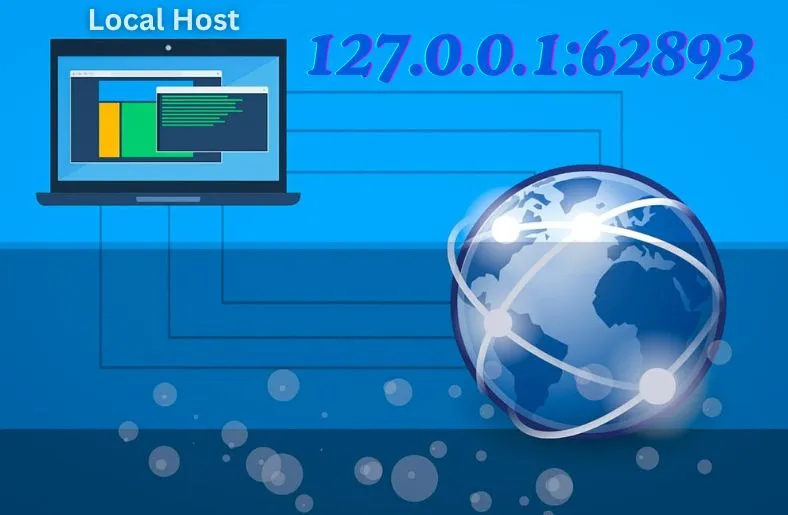127.0.0.1:62893 is a specific address that might appear perplexing to many users. Essentially, 127.0.0.1 refers to the localhost, which is your own computer. The number 62893 is a port, serving as a gateway for data exchange. Understanding and troubleshooting issues related to 127.0.0.1:62893 is crucial for developers. It can enhance efficiency and ensure seamless operations.
This guide aims to demystify this address, offering clear explanations and practical solutions. We will delve into its significance, common errors, and step-by-step troubleshooting methods. Additionally, we’ll explore its applications in development environments. By the end, you’ll have a comprehensive understanding of how to handle issues related to 127.0.0.1:62893, making your development process smoother and more efficient.
I. Understanding 127.0.0.1:62893
127.0.0.1, commonly known as the loopback address, is an essential component in networking. This address allows a computer to communicate with itself. It’s used for testing and development, ensuring that network applications run smoothly.
Port 62893 acts as a gateway for data exchange between applications. While not as commonly used as other ports, it plays a crucial role in specific scenarios. Developers often use this port for local testing and debugging. Tools like Visual Studio Code and frameworks like Django utilize it during development.
Applications and scenarios involving 127.0.0.1:62893 are varied. Developers use it for remote debugging, enabling them to identify and fix issues on local servers. Additionally, it supports secure, isolated environments for testing, preventing conflicts with other applications. Understanding this address and port combination is key to efficient troubleshooting and development.
II. Common Errors and Issues
- Connection Errors: Often, the primary issue is the debugger failing to connect to the target machine. There are multiple possible causes for this problem.
- Service Not Running: One common problem is that the required service isn’t running. Ensure the service or application is active.
- Port Conflicts: Sometimes, another application may already be using port 62893. This conflict can prevent the intended application from accessing the port.
- Firewall Blocks: Firewalls can block traffic on port 62893. This blockage can disrupt communication between applications.
- Misconfigured Settings: Incorrect settings in the application can lead to errors. Verify that all configurations match the required specifications.
- Network Issues: General network problems can affect connectivity. Ensure your network is stable and functioning properly.
- Permission Issues: Lack of proper permissions can prevent the application from using the port. Check and adjust permissions as needed.
III. Troubleshooting Steps
Before diving into troubleshooting, it’s crucial to perform some preliminary checks to streamline the process. Ensure that:
- Services Are Running: Confirm that the necessary services or applications are active and operational on your system. Check the status of any relevant processes or servers associated with port 62893.
- Port Usage is Correct: Double-check that the application is indeed utilizing port 62893 for communication as intended. Review the application’s configuration settings to verify the port number assignment.
Once these preliminary checks are complete, proceed with the step-by-step troubleshooting guide.
step-by-step troubleshooting guide.
- Restart Services: Sometimes, a simple restart can resolve connectivity issues. Try restarting the relevant services or applications associated with port 62893. This can help refresh the connection and address any underlying issues.
- Configure Firewall Settings: Check your firewall configurations to ensure that port 62893 is not being blocked. If necessary, create exceptions to allow traffic through this port for both inbound and outbound connections. Adjusting firewall settings can often resolve connectivity problems related to port access.
- Use Network Diagnostic Tools: Employ tools like netstat or lsof to diagnose any issues with port 62893. These tools provide insights into network activity and can help identify if any applications are actively using the port. Analyze the output to determine if there are any conflicts or issues with port allocation. Additionally, consider running network diagnostics or packet capture tools to further troubleshoot connectivity problems.
IV. Advanced Solutions
When standard troubleshooting methods fall short, advanced solutions can offer additional avenues for resolving issues related to port 62893. Consider the following:
- Configuring Alternative Ports: To avoid conflicts, consider configuring the application to use alternative ports instead of 62893. This can help circumvent any issues with port allocation and ensure smooth communication.
- Adjusting Application-Specific Settings: Dive into the application’s settings to make adjustments tailored to its requirements. This might involve fine-tuning configurations related to port usage and communication protocols.
- Creating Firewall Exceptions: If firewall restrictions are hindering port 62893, create exceptions to allow traffic through. Detailed instructions for configuring firewall settings on both Windows and Mac/Linux systems are provided below:
Creating Firewall Exceptions for Port 62893
Detailed Instructions for Windows:
- Go to the Control Panel, then choose “System and Security.”
- Click on “Windows Defender Firewall” and then choose “Advanced Settings.”
- Within the “Inbound Rules” section, select “New Rule” and specify port 62893.
- Follow the on-screen prompts to create a firewall exception for port 62893.
Detailed Instructions for Mac/Linux:
- On Mac, access firewall settings through System Preferences, then Security & Privacy.
- Go to the “Firewall” tab and select “Firewall Options.”
- Add port 62893 to the list of allowed incoming connections.
- On Linux, configure firewall settings using commands like iptables to allow traffic on port 62893.
V. Practical Applications
The address 127.0.0.1:62893 is not just a technical concept but has several practical applications.
- Development and Testing: Developers frequently use 127.0.0.1:62893 for local testing. It allows them to simulate server interactions without needing an external server. This setup is essential for debugging and testing new features in a controlled environment.
- Remote Debugging: Tools like Visual Studio Code use this address for remote debugging sessions. By connecting to 127.0.0.1:62893, developers can test their code on a local server while controlling it remotely. This facilitates the effective detection and fixing of issues.
- Memcached Usage: Memcached, a popular caching system, sometimes uses port 62893. This setup helps in speeding up database-driven websites by caching data and reducing load times.
- Network Configurations: Understanding 127.0.0.1:62893 is crucial for configuring network settings. It helps in setting up localhost connections, ensuring secure and efficient data transmission within the same machine.
VI. Security Considerations
When it comes to security, it’s essential to understand the risks associated with exposing port 62893 publicly. One major concern is the potential security exploits that attackers could leverage if they gain access to this port. Additionally, DoS (Denial of Service) attacks pose a significant threat, as hackers can overload the system and cause it to crash by targeting port 62893. Unauthorized access is another risk, as anyone with internet connectivity could attempt to connect to services running on this port, leading to potential breaches. To mitigate these risks, it’s crucial to implement best practices for securing port 62893. This includes monitoring port activity regularly to detect any suspicious behavior and implementing access controls to restrict unauthorized access.
FAQs
Q: How can I find out which applications are actively using port 62893?
Ans: Use network diagnostic tools like Netstat (Windows) or lsof (Unix/Linux) to identify active connections and listening ports. These tools provide insights into applications using port 62893.
Q: Is it safe to expose port 62893 publicly for remote access?
Ans: Exposing port 62893 publicly poses security risks. Implement access controls and monitor port activity to mitigate unauthorized access.
Q: What are the implications of DoS attacks targeting port 62893?
Ans: DoS attacks on port 62893 can overwhelm systems, causing downtime. Robust security measures can help mitigate such attacks.
Q: How do I configure firewall settings for port 62893?
Ans: Create an exception rule in your firewall software. On Windows, access Control Panel > Windows Defender Firewall > Inbound Rules, then add a rule for port 62893. For Mac/Linux, use terminal commands like iptables.
Q: What potential security exploits are associated with port 62893?
Ans: Security vulnerabilities in services on port 62893 can lead to unauthorized access or malicious activities. Regular updates and access controls mitigate these risks.
Conclusion
this guide has covered essential aspects of understanding and troubleshooting 127.0.0.1:62893. We’ve highlighted the significance of proper configuration and security measures to prevent potential risks. It’s crucial to apply the provided resources for further assistance, ensuring a smooth experience with port 62893. By recapping key points discussed throughout this guide, users can confidently navigate issues and optimize their system’s performance.





